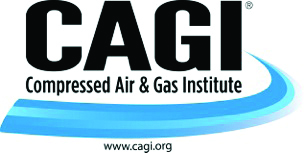While oxygen is unquestionably the most important gas in our atmosphere, as it is essential for most animals and human life, nitrogen is the most widely used atmospheric gas. Nitrogen is the go-to gas for countless industrial, medical, and scientific applications. This is because nitrogen is in vast supply, inert, and possesses the desirable characteristics of being colorless, odorless, and tasteless. The purity of nitrogen significantly affects the outcome of the application for which it is used and how the industry measures the purity of nitrogen gas is the focus of this article.
Stating the Purity of a Stream of Nitrogen (N₂) Gas
A 16-ounce beer glass contains 8 ounces of delicious, craft-brewed beer. Is the glass half-full or half-empty? Psychologists will position that the “half-full” answer reflects an optimist whereas a “half-empty” answer reflects a pessimist. Regardless of the psychological interpretations, both answers are correct statements of the volumetric condition of the glass.
A similar dual-answer scenario exists when stating the purity of a stream of nitrogen (N₂) gas. The atmosphere is comprised of 78% nitrogen and 21% oxygen with all other gasses representing the remaining 1% of the atmosphere. Since these two gasses are the predominant atmosphere constituents, the purity of nitrogen in a N₂ gas stream is typically stated as either the percentage of nitrogen in the sample relative to oxygen or, alternately, by the amount of O₂ remaining within the sample as measured in ppm of O₂. For example, a nitrogen stream that is rated at 95% purity will contain 5% O₂. This means that in a 1-million molecule sample of 95% purity nitrogen, there will be 50,000 molecules of O₂, an O₂ content of 50,000 ppm. Another way of stating the purity of the 95% pure nitrogen would be to state that the gas stream has an O₂ content of 50,000 ppm.
.jpg)
Wall-mounted membrane N₂ generator, such as might be used for dispensing beer.
Nitrogen purity below 99.5%, an O₂ concentration of greater than 5,000 ppm, is usually stated in terms of the percentage of nitrogen in the sample. As nitrogen purity levels reach 99.9% and higher, it is more common for the nitrogen purity to be stated in reference to the ppm of O₂ remaining in the process gas stream. For example, a process gas stream having a nitrogen purity of 99.9% will be stated as having an O₂ content of 1,000 ppm. Similarly, a process gas stream having a nitrogen purity of 99.999% will be stated as having an O₂ content of 10 ppm. As the nitrogen purity increases, stating its purity in terms of the remaining O₂ content is a more precise measurement. Also, the convention within the gas industry is to state the concentration of N₂ as the total number of “9s” both to the left and to the right of the decimal point of its purity percentage. For example, a N₂ purity of 99.9% will be referred to as 3-9s of purity. The above-described stream of N₂ containing 10 ppm of O₂, 99.999% N₂ purity, will be referred to as a gas purity of 5-9s.
Facility Generated Nitrogen
Since nitrogen is quite plentiful within our atmosphere, it is economical for small to large nitrogen users to invest in facility generated nitrogen rather than rely on the delivery of cryogenic N₂. Gaseous separation of nitrogen from the atmosphere involves either Pressure Swing Adsorption (PSA) or Membrane separation technology.
PSA nitrogen generation involves passing compressed air through a bed of adsorbent material, typically Carbon Molecular Sieve (CMS), that has been selected to adsorb oxygen. O₂ bonds to the adsorbent material. This results in a nitrogen enriched gas stream with N₂ purities in the range of 95% to 99.999%. Once the adsorbent material has become saturated with O₂ it is desorbed by a pressure reduction and the O₂ returns to the atmosphere. To supply a continuous flow of nitrogen gas to the process, PSA systems typically use twin adsorption towers, one of which is generating N₂ while the other tower is regenerating itself by desorbing O₂.
Membrane technology involves passing compressed air through a membrane consisting of hollow filaments that are perforated with microscopic pores. The pores allow the smaller O₂ molecules, along with water vapor, to permeate the filament and exhaust to atmosphere while the larger N₂ molecules remain within the filaments and are exhausted as a continuous stream of N₂ in the purity range of 95% to 99.9%. Purities higher than 99.9% can be achieved with membrane technology, but to do so requires significantly more compressed air than is required by a PSA system of equal purity and production capacity.
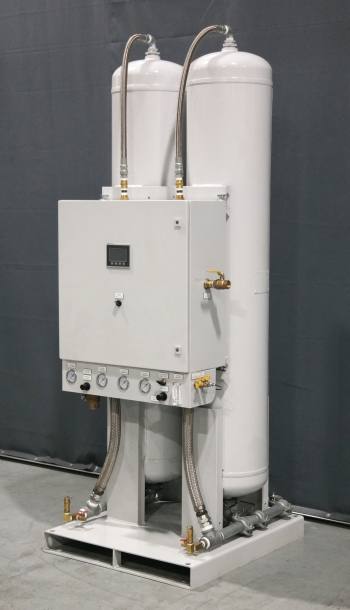
Small, twin tower PSA N₂ generator. (Note: Some designs may include multiple pairs of beds.)
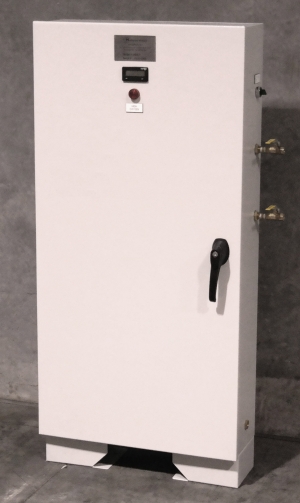
Small, cabinet membrane N₂ generator.
Typical Facility Generated Nitrogen Applications
The reason why the oxygen content in a stream of nitrogen gas is so important is because many industrial processes are adversely affected by the presence of even small concentrations of oxygen. Oxygen is an extremely reactive molecule that attracts electrons from other elements and oxidizes them. Oxygen is responsible for many of the undesirable oxidation reactions that occur in nature and industry: rusting steel, spoiling organic matter (food), and unwanted combustion of flammable liquids. Thus, controlling the oxidation process in industrial applications involves either eliminating oxygen or reducing the oxygen to nitrogen ratio to the point that the oxygen is incapable of producing detrimental amounts of oxidation.
Described below are three typical applications where a facility generated, enriched nitrogen atmosphere is critical.
Long term fruit storage: Oxygen causes fruit to spoil. To eliminate the oxidation of stored apples, the cold storage room is flooded with low purity nitrogen. Nitrogen purity levels of 95% to 99% adequately do the job allowing apples to remain fresh in storage for 6 months or longer. The N₂ source for this application is mainly supplied by gaseous membrane separation systems.
Circuit board soldering: The electronics industry relies on high-quality soldered connections to join electrical components together on printed circuit boards. The to-be joined components are wetted with hot, liquid metal (solder) that hardens to form a long-lasting joint. Oxygen in the process in as small a concentration as 1000 ppm reacts with the hot liquid solder creating metal oxides, known as dross, which interfere with the soldering process. Soldering in a nitrogen enriched environment that has an O₂ content not greater than 1000 ppm reduces dross production, increases joint integrity, and increases productivity by minimizing scrap and re-work. Depending on the size of the soldering operation, the required volume of 3-9s purity N₂ can be supplied by either membrane or PSA technology.
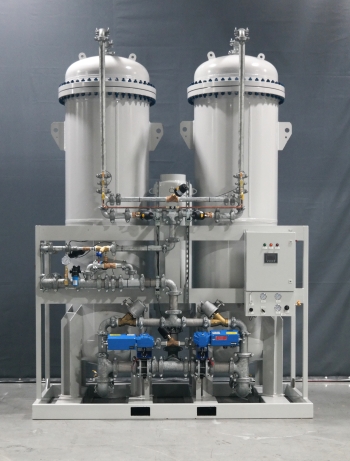
A large PSA style N₂ generator such as might be used for circuit soldering applications – capable of 10,500 SCFH of 99.995% N₂ (less than 50 ppm O₂.)
High speed laser cutting of thick stainless steel: During the cutting process, O₂ in the atmosphere will allow oxidation at the cut edges, making them tarnished and unable to allow paint to adhere in the cut area. To achieve a bright, no-tarnish finish when laser cutting ½” or thicker stainless steel, the cut must be isolated with a cone of high purity nitrogen having a purity range of 99.99% to 99.999% (4-9s to 5-9s) … that’s an oxygen content of no greater than 100 ppm to 10 ppm. The faster the cutting speed, the higher the purity of nitrogen that is required. The N₂ source for this application is mainly supplied by gaseous PSA separation systems that can economically deliver both the purity level and volume required for this continuous operation.
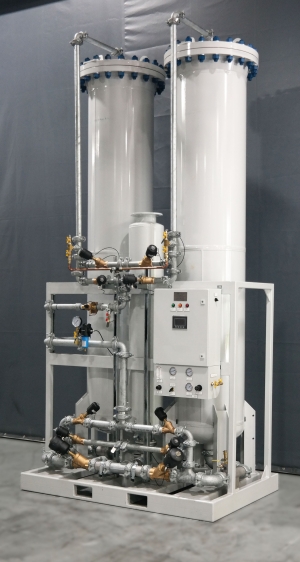
Mid-sized PSA N₂ generator as often used for laser cutting operations – produces 5700 SCFH of 99.99% N₂ (less than 100 ppm of O₂.)
Nitrogen is the preferred gas for industrial and scientific applications because of its utility in accomplishing the following:
- Prevent oxidation of materials
- Prevent bacteriological growth
- Reduce the level of combustion-supporting gas
- Prevent O₂ incursion into processes
- Provide a dry atmosphere
In all of the above processes, nitrogen is introduced to reduce the concentration of oxygen and eliminate or reduce the detrimental effects of oxidation. The nitrogen purity that is required depends upon the application and how much oxygen the nitrogen gas is required to displace. The convention within the gas generation industry is to state the purity of lower-purity nitrogen streams as the percentage of N₂ while stating the purity of higher-purity nitrogen streams by the ppm of O₂ remaining in the gas stream.
Conclusion
Facility generated nitrogen generation systems provide a reliable, efficient, and safe solution to supplying the nitrogen which industry requires. Two processes are used for facility generated N₂ generation: Pressure Swing Adsorption (PSA) and Membrane separation. Both methods can produce low and high purity N₂ in acceptable volumes to satisfy the majority of applications found in industry. Selecting the best N₂ generation source depends upon the purity of nitrogen required, the volume of nitrogen required, and the costs of the generation equipment. Industries that invest in facility generated nitrogen generation systems are discovering that they can economically and reliably harvest the endless supply of nitrogen in the atmosphere to deliver a continuous supply of high purity, clean, and dry nitrogen gas to satisfy their production requirements. On site N₂ generation systems have proven to be a reliable and economical alternative to storing and utilizing cryogenically produced N2.
|
The Compressed Air and Gas Institute (CAGI)The Compressed Air and Gas Institute (CAGI) is the united voice of the compressed air industry, serving as the unbiased authority on technical, educational, promotional, and other matters that affect compressed air and gas equipment suppliers and their customers. CAGI educational resources include e-learning coursework, selection guides, videos, and the Compressed Air & Gas Handbook.
For more information, visit the CAGI web site at www.cagi.org, and follow CAGI on LinkedIn. |
To read more Nitrogen Generation Technology articles, visit https://www.airbestpractices.com/technology/air-treatment.
Visit our Webinar Archives to listen to expert presentations on Nitrogen Generation Technology at https://www.airbestpractices.com/webinars.
Published April 2024

